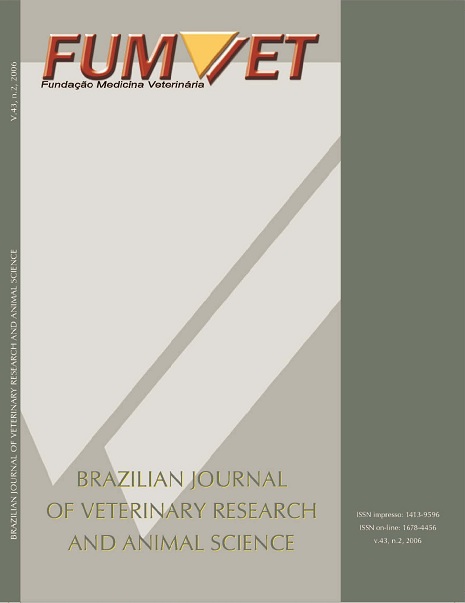Radiographic, densitometric and histological evaluation of the use of bone perforations on fracture consolidation of distal third of radius from dogs
DOI:
https://doi.org/10.11606/issn.1678-4456.bjvras.2006.26498Keywords:
Fractures, Bone drilling, Densitometry, Histology, DogAbstract
To stimulate the bone callus development process from distal third of radius, 24 adult mongrel dogs used were from both sexes. These dogs were separated in two experimental groups of 12 animals each, named control and treated, divided in 4 moments (M1=15 days; M2=30 days; M3=45 days; M4=60 days), who underwent were performed surgical fractures. In treated group, it was performed bone perforations on proximal and distal edges, craniolateral and mediolateral to the fracture site. At the end of each moment, control and treated animals were evaluated by radiography, histology, and bone mineral densitometry (BMD) was determined on fracture site. According to the radiographic data of treated dogs, it was verified on days 15 and 30 more intense bone regeneration than control group. During M3 and M4, it wasn't detected any difference in bone reparation process betweencontrol and treated groups. In densitometric study, BMD values were greater in treated animals than in control dogs. Histological studies revealed at 15 and 30 days chondrocyte hyperplasia and initial endochondral ossification on drilled limbs; control group showed sustainment connective tissue and initial chondrocyte hiperplasia. At M3 and M4 of the treated group, were verified development and remodeling of periosteal callus in more advanced phases when comparing with limbs from control group. It can be concluded that using perforations enhances blood flow supply and activation of osteogenic cells on fracture site, stimulating the beginning of fracture consolidation process.Downloads
Download data is not yet available.
Downloads
Published
2006-04-01
Issue
Section
UNDEFINIED
License
The journal content is authorized under the Creative Commons BY-NC-SA license (summary of the license: https://
How to Cite
1.
Guerra PC, Vulcano LC, Rocha N de S. Radiographic, densitometric and histological evaluation of the use of bone perforations on fracture consolidation of distal third of radius from dogs. Braz. J. Vet. Res. Anim. Sci. [Internet]. 2006 Apr. 1 [cited 2024 Jul. 26];43(2):186-95. Available from: https://www.revistas.usp.br/bjvras/article/view/26498





